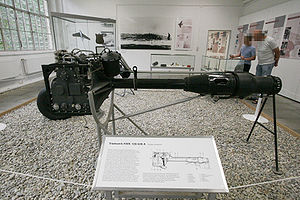Walter HWK 109-509
| HWK 509 | |
|---|---|
 |
|
| HWK 109-509A on display at the Luftwaffenmuseum, Berlin-Gatow, Germany | |
| Type | Rocket engine |
| Manufacturer | Hellmuth Walter Kommanditgesellschaft |
| First run | 1943 |
| Major applications |
Messerschmitt Me 163 Bachem Ba 349 |
The Walter HWK 109-509 was a German liquid-fuel bipropellant rocket engine that powered the Messerschmitt Me 163 Komet and Bachem Ba 349 aircraft. It was produced by Hellmuth Walter Kommanditgesellschaft (HWK) commencing in 1943.
Early versions of the Me 163 had been powered by an earlier design running on a "cold engine" fueled with Z-Stoff. This fuel tended to clog the jets in the combustion chamber, causing fluctuations in power and potentially explosions. Worse, however, was the fact that the engine could not be throttled, and when the aircraft leveled off after its climb to altitude it quickly accelerated to speeds that caused serious compressibility issues. The RLM demanded that a version be developed with a throttle.
During this period Walter has also been working with a new fuel known as C-Stoff that gave off significant heat and was thus known as the "hot engine". C-Stoff was a mix of 30% hydrazine hydrate + 57% methanol + 13% water with a small amount of potassium-copper-cyanide. The oxidizer, known as T-Stoff, consisted of a hydrogen peroxide-based formulation. The two reacted violently on contact. The violent combustion process resulted in the formation of water, carbon dioxide and nitrogen, and a huge amount of heat sending out a superheated stream of steam, nitrogen and air that was drawn in through the hole in the mantle of the engine, thus providing a forward thrust of approximately 17 kN (3,800 dbf).
To address the throttling issue, the new engine included turbopumps with two settings. The pumps were driven by a single turbine, powered by steam created by decomposing the T-Stoff with a wire mesh catalyst. Combined with a mechanical throttle, this provided four power settings from idle to full power for climbing. In practice it was found that throttling the engine dramatically decreased its fuel economy to the point that it did not extend the endurance of the aircraft as expected. This version was put into the Me 163B in spite of this problem.
...
Wikipedia
